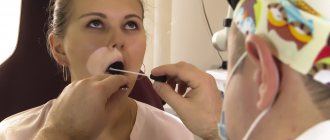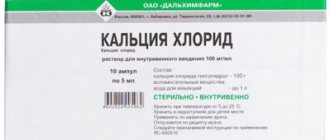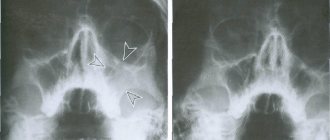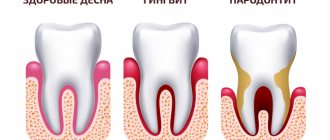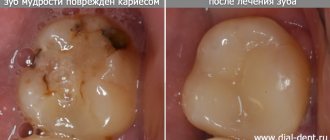Treatment of acute laryngitis in ENT clinic No. 1
Author:
- Golonova Yulia Yurievna
otorhinolaryngologist, clinic director
5.00 (Votes: 2)
The most important sign of acute laryngitis (inflammation of the larynx and vocal cords) is hoarseness, hoarseness and a barking, painful cough. Most often, acute laryngitis is a consequence of acute respiratory viral infection (ARVI).
Why does acute laryngitis deserve special attention?
Acute laryngitis is a disease that cannot be ignored, hoping for “maybe”, especially since it is impossible to continue working during inflammation of the vocal cords, especially for people in “voice specialties” (actors, announcers, journalists, teachers, doctors, etc.) We must remember that the vocal apparatus must be treated very carefully, since a person is very social, and the main means of communication is the voice. Be sure to contact an ENT doctor to examine the vocal cords, prescribe treatment and issue a certificate of incapacity for work.
Diagnostics
When treating laryngitis, first of all, an otolaryngologist performs an initial diagnostic examination using laryngoscopic instruments and mirrors, and takes smears for laboratory analysis.
If necessary, a detailed assessment of the condition of the larynx is carried out using a rigid telescope, which magnifies the image of the pathological area.
At the next stage, a biopsy may be performed. Additionally, a general blood and urine test is prescribed. Based on the results of the study, the otolaryngologist sees the full clinical picture of the disease and prescribes the necessary therapy.
Why are vocal cords easily injured during inflammation?
There are two true vocal cords. At rest, they are at a fairly large distance from each other, forming a triangle with a wide base and coming together only in the area of the anterior ends (at the point of their connection), while the edge of each vocal cord is free.
When producing sound (and when coughing), the vocal cords come closer and touch each other. During inflammation, the edges of the vocal cords are swollen, inflamed and very easily injured during voice formation, as well as when coughing, which can not only increase their inflammation, increase the duration of the recovery process of the vocal cords, but also contribute to the chronicity of inflammation and provoke the appearance of benign neoplasms along the edge of the vocal cords , coarsening of the edges of the vocal cords and, as a result, a change, deepening of the voice. Therefore, it is so important to remain silent during their inflammation, maintaining a safe distance between the vocal cords, avoiding their traumatization.
Symptoms of the disease
Laryngitis begins with sharp intense pain, soreness and a feeling of a “lump” in the throat. It is difficult and painful for the patient to speak, the voice becomes hoarse. Against the background of hyperemia of the larynx, difficulties with swallowing and breathing may occur. As the disease progresses, symptoms of intoxication appear - headache, fever, chills, weakness. Inflammation is accompanied by a convulsive, hysterical cough that does not bring relief, during which a large amount of sputum is released, sometimes mixed with pus.
Types of viral laryngitis in children
Viral laryngitis is especially dangerous in children, because it can lead to the development of false croup, which is accompanied not only by suffocation, but also by metabolic disorders in the body. Most often, this disease is called inflammation of the larynx, and this occurs due to different viruses: measles, chickenpox. But still, the most dangerous and contagious are both Adenoviruses and Rhinoviruses.
But in fact, laryngitis is classified not only by the type of virus itself, but also by the duration of the disease. They come in the following options:
- acute, lasting from 1 to 2 weeks;
- chronic, often lasting more than a month;
- specific, caused by other infections.
In the latter case, we can talk about diphtheria, syphilis or tuberculosis. But these diseases most often occur in adults. There are also nonspecific laryngitis caused by microbes.
Laryngitis or cold
Very often, laryngitis in children is confused with the common cold. This leads to the fact that the disease, due to improper treatment, can not only drag on for a longer time, but also cause additional complications. Usually this happens for one single reason: the mother believes that it is a cold that she can cope with on her own.
The symptoms of a cold and laryngitis are slightly different. In the second case, the mother must pay attention to the following symptoms in the child:
- sore throat, which may get worse when eating food or even when swallowing saliva;
- a cough that does not bring any relief at all, and is often called “barking”;
- an increase in temperature, and by this sign it will be possible to determine whether it is a viral or bacterial disease;
- poor health when the child experiences lethargy and fatigue.
A mother should definitely listen to how her child coughs. If metallic notes are clearly heard, this is a bad sign. This is evidence that the lumen of the larynx is already very narrowed, which can lead to suffocation.
Reasons for appearance
In fact, laryngitis can be not only viral, but also bacterial and allergic, so you need to know the type of pathogen. In this case, it will be possible to choose the right treatment, which will help get rid of the disease faster.
- Laryngitis as an independent disease is caused by physical factors. For example, this can happen both from hypothermia of the child’s body, and as a result of his cry. In the second case, the ligaments are overstrained. Another option is dust in the air in the room.
- Viral laryngitis is usually a consequence of acute respiratory viral infection, measles or other similar diseases, which is especially common in childhood.
- Microbial laryngitis, usually resulting from certain infectious diseases.
- Allergic laryngitis, when swelling of the larynx occurs. This may occur due to the body’s reaction to certain medications or when a child gets an allergen in the throat with food.
- Chronic laryngitis is usually a consequence of an untreated disease, when inflammation persists in the nasopharynx area.
Why describe all this when we are talking about viral laryngitis? All this information is given so that the mother can understand that the symptoms may be similar, but we are talking about completely different laryngitis. This means the following: each specific case must have its own treatment.
Viral laryngitis: disease development
Viral laryngitis is a consequence of influenza or other colds. The incubation period of this disease does not differ in its duration; it can last only from 1 to 5 days. This is due to the fact that when the virus enters the body, it develops rapidly. Since the child’s body is just developing, it often happens that after contact with a carrier of this virus, the disease can develop very quickly, even in a matter of hours. The disease spreads very quickly, especially when the carrier of the virus attends a kindergarten or school.
When laryngitis appears, the mucous membrane immediately changes. And this applies not only to the larynx, but also to the epiglottis. Redness and swelling of the mucous membrane appears, and this occurs not only due to the multiplication of the virus, but also from the activation of local immunity. Due to the accumulation of clear mucus, a cough appears. The child’s voice also changes, and may even disappear completely. If treatment is not started, pathogenic bacteria will appear. In this case, viral laryngitis can become secondary bacterial.
It is important to know: you cannot allow the disease to “descend” into bronchitis, otherwise it will lead to epiglottitis. This is very dangerous for any child.
Since laryngitis viruses multiply quickly, the disease usually manifests itself abruptly. A sore throat can occur almost suddenly, and the mother is at a loss as to why a cheerful and active child suddenly becomes lethargic. The baby's behavior often changes before our eyes. If it is a baby, he begins to cry and completely refuses the breast. And when it comes to an older child, he almost suddenly becomes capricious. In this case, it is necessary to start treatment as quickly as possible in order to stop the reproduction of the virus, and then completely get rid of it.
Diagnosis of viral laryngitis
Since viral laryngitis can occur for various reasons, including due to impaired nasal breathing, it is necessary to select the correct treatment. But first you need to undergo a diagnostic examination, which an experienced doctor can do. Using a special instrument, the vocal cords are first checked. This will help determine both the nature of the inflammation and the extent of swelling.
With laryngitis, other diseases can also develop, so you need to check not only the throat, but also the lymph nodes and nose of the child. To determine a more complete picture, the doctor uses a laryngoscope to examine the larynx. In some cases, he may prescribe a biopsy. We are talking about a throat swab. In this case, you need to take a tissue sample for testing in the laboratory. And in the most difficult cases, a computed tomography scan of the larynx is prescribed.
Treatment of the disease: folk remedies
Treatment of viral laryngitis in a child can be difficult. To avoid complications, he must remain silent and cannot cry. Particular attention should be paid to the room where the baby is. The air should under no circumstances be dry, otherwise this will lead to the spread of swelling of the mucous membrane. If the child is older, he should not be given spicy, hot or cold food. It should only be warm, just like drinking water.
There are two treatment options for viral laryngitis in children, and each of them has its own characteristics. The first of them is folk remedies:
- steam inhalation with potatoes;
- gargling with boiled beet juice;
- use of honey solution for rinsing;
- using a decoction of dill seeds.
With this disease, you need to use as much warm drink as possible. This will relieve tension in your throat and you will be able to stop coughing so often.
Drug treatment
Every mother should know that viral laryngitis in children cannot be treated with antibiotics. Here the emphasis should be on antiviral drugs. It is best, and this will bring a quick positive result, if you start taking medications on the first day of the onset of the disease.
With viral laryngitis, it is necessary to relieve laryngeal edema as quickly as possible. This is done with the help of Suprastin. You also need to monitor the child's body temperature. If it turns out to be high, medications containing ibuprofen will help. For children, natural medicines such as Immunoflasit are better.
Drug treatment
To combat infections that act as the main cause, antibiotics are indicated. Medicines are used as prescribed by a doctor. Mainly attributed to drugs from the groups of macrolides, penicillins and cephalosporins. The duration of the course of therapy is determined by a specialist based on clinical data.
Symptomatic medications are prescribed:
- Antiseptics - Ingalipt, Septolete, Faringosept. Available in aerosol and tablet form.
- Antitussives and expectorants - Aflubin, Brombexin, Travisil.
- Vitamin complexes. All groups of vitamins are used, but especially ascorbic acid.
- Essential oils, saline solution and dry raw materials of medicinal plants for inhalation.
The main drugs in the treatment of laryngitis are:
- Berodual - used at the beginning of the disease, when there are no obvious signs. Helps liquefy and remove mucus. Used as a spray or in a nebulizer system.
- Lizobakt - has a pronounced antiseptic effect. Available in tablet form for adults and children.
- Lugol - has some irritating and bactericidal effects, helps fight the causes of pathology and eliminates unpleasant symptoms.
- Pulmicort is an excellent remedy with strong anti-edematous properties. More often used in pediatric practice to prevent swelling of the pharynx.
- Hexoral is a drug with a wide spectrum of therapeutic action. Has antimicrobial and antifungal effect. Used in the form of syrup or spray to irrigate a sore throat.
